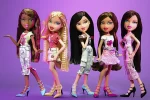Barbie has been paving the way for feminism since her first appearance in 1959. In doll form, she has been a veterinarian, a chef, a teacher, an astronaut and even the first female president. Beginning in 2001, Barbie began starring in a number of feature films that both entertained and inspired an entire generation of girls. The films were not just fluff meant to sell merchandise, but instead taught girls valuable life lessons that are still applicable even when they grew up.
I chose the following five films out of the 36 ‘Barbie’ movies that Mattel has produced over the years because these are the stories that millennials grew up with, and also, let’s face it, they are the most iconic.
1. “Barbie in the Nutcracker”
“Barbie in the Nutcracker” was released direct to DVD in 2001 as the first CGI feature film to star Barbie as the central heroine. The plot is loosely based on the 1816 story “The Nutcracker and the Mouse King,” written by E. T. A. Hoffmann, and the music is borrowed from the subsequent ballet, “The Nutcracker,” which was scored by Pyotr Ilyich Tchaikovsky.
The film opens with Barbie and her little sister, Kelly, practicing the “Dance of the Sugar Plum Fairy.” When Kelly stumbles over and over again, she becomes disheartened and laments that she is “never going to get these steps right!” Barbie decides that now is good time to recount the story of Clara and the Nutcracker to help cheer Kelly up.
In the new setting, the Nutcracker needs Clara’s help to find the Sugarplum Princess, as she is the only one who can reverse the evil Mouse King’s spells. Even when the going gets tough, Clara is unwilling to give up and offers emotional support and guidance to her companions. She even traverses alone to save her captured friends despite her nerves.
In the end, Clara is revealed to be the Sugarplum Princess herself, and Kelly finally understands why Barbie told her the story in the first place. “If Clara hadn’t been brave, she never would’ve found out she was a princess!” she summarized. With newfound motivation, the sisters turn the music back on and this time, Kelly dances perfectly.
Although it is not an original idea, “Barbie in the Nutcracker” helped girls to realize the importance of courage and not giving up.
2. “Barbie as Rapunzel”
“Barbie as Rapunzel” is the second entry to the Barbie film series and was released direct to DVD in 2002. The film is adapted from the titular fairytale written by the Brothers Grimm.
Barbie and Kelly are now in a paint studio, with the elder already hard at work. Kelly stares at her blank canvas and stresses that she does not know what to paint. Barbie pulls out the story of Rapunzel tucked in her back pocket to help give Kelly the confidence boost she needs.
Rapunzel is a servant to the evil witch Gothel, who resides in a manor hidden in the woods. Rapunzel spends her spare time painting and daydreaming about being free.
One day, she discovers a magic paintbrush that turns anything she paints into a reality. This leads her on a journey to a small kingdom, where she meets new people and even the future love of her life. Rapunzel uses her heart and her dreams to paint her way out of trouble numerous times.
After Rapunzel ends a feud between two kingdoms and traps Gothel forever, Kelly wishes that she had a magic paintbrush as well. Barbie is quick to point out that the true magic of art comes from within. Kelly smiles and dips her brush into blue paint.
“Barbie as Rapunzel” inspired thousands of young artists to pick up a paintbrush and trust in their creativity.
3. “Barbie as the Princess and the Pauper”
“Barbie as the Princess and the Pauper” was a 2004 direct-to-DVD release and the first musical of the film series. The film is loosely adapted from the 1881 Mark Twain novel, “The Prince and the Pauper.”
Princess Anneliese often dreams about having one day to herself with “no one to say when to eat or read or leave or stay.” Pauper Erika has a similar wish: a day in which she does not have to work for a cruel and unpleasant seamstress.
When the two girls cross paths in the town square, they realize that they have identical faces despite having no relation. They decide to switch places and lead the lives they each dreamed of having, even if only for a little while.
In consequence, chaos ensues, and the girls must figure out how to save the kingdom from the clutches of the queen’s traitorous advisor with the help of their male partners and their feline sidekicks.
The lesson learned in “Barbie as the Princess and the Pauper” is not only that the grass is not always greener on the other side, but that you should always be true to yourself, even if you do not fit the mold you are expected to fill.
4. “Barbie: Fairytopia”
“Barbie: Fairytopia” was released direct-to-video in 2005 and is the first of the series to have an original storyline not based on preexisting material.
Elina is a flightless flower fairy living in the land of Fairytopia. She is judged and bullied for her lack of wings, but her puffball friend, Bibble, always remains by her side.
When the evil enchantress Laverna kidnaps the guardians of Fairytopia and unleashes a poison that weakens the wings of every flying creature, it is up to Elina and Bibble to embark on the treacherous journey to save the day.
The two friends manage to succeed, and in doing so, Elina earns the gift of her very own pair of wings.
“Barbie: Fairytopia” taught insecure little girls that what makes you different is also what makes you special and to cherish your best friend because together you are strong.
5. “Barbie as the Island Princess”
“Barbie as the Island Princess” was a 2007 direct-to-video release and is the second musical in the series.
Ro was shipwrecked on an island as a little girl, which left her with no memory. She spends the next 10 years playing with her animal friends until a ship carrying a handsome prince arrives, and he convinces Ro to come back to the mainland with him.
Although she is terrified, Ro’s curiosity of a new world and discovering her past gets the best of her.
Once on land, Ro discovers that the queen of a neighboring kingdom is actually planning on overthrowing the prince’s domain. Ro uses the skills she learned on the island to foil the evil plot and not only saves the kingdom but reunites with her long-lost mother as well.
Similar to “Moana,” “Barbie as the Island Princess” encouraged girls to face their fears and follow their hearts.
Don’t mind me, I’m just going to pop in one of the DVDs and relive my childhood.

















